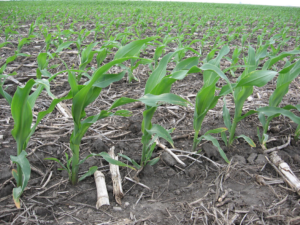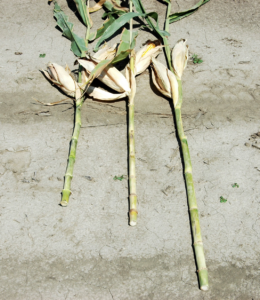- Corn plant height potential is determined by genetics but modified and influenced by the environment. Specific factors that affect height include water intake, temperature, and light interception by top leaves during growth.
- Low early-season temperatures can increase internode rigidity and limit cell expansion and
internode elongation. - Plant height does not necessarily influence yield potential.

Figure 1. Corn in V5 growth stage.
Drivers of Internodal Growth
Stalk elongation begins at the V5 growth stage (Figure 1). Most cell expansion occurs at the base of internodes and is affected by light and shade interactions, day length, and temperatures. Later planting dates often result in taller corn because longer days typically produce elongated internodes. Corn fields with high populations can have a ‘shading effect’. This shading leads to increased auxin production.1 Auxin is a plant growth hormone that helps facilitate the expansion of internodes, resulting in taller plants. Conversely, intense solar radiation can reduce auxin levels, leading to less internode elongation (Figure 2).

Figure 2. Shortened internode on plant to left compared to normal internode elongation on right.
Cell wall expansion within the internodes is limited by cold temperatures, and internodes may become rigid if exposed to a cool period during vegetative growth. Therefore, early planting dates can be associated with short corn heights as they have a higher chance of being exposed to cool spring weather and shorter day lengths. Earlier planting dates usually result in shorter corn compared to later planting dates as early planted corn has more vegetative growth occurring when days are shorter, soils and air temperatures are cooler, and often in saturated soils. Saturated soil is unfavorable for root and shoot development and is prone to compaction when driven on during spring field work. Compacted soil from equipment can lead to shorter corn in rows adjacent to the tracks.2 Early root development that is inhibited from these early-season conditions can limit moisture and nutrient uptake during the rapid growth stage of corn. Water stress can impact plants with normal root development as cell expansion depends on water uptake. Reduced water uptake can result in shorter internodes because of limited water availability.
Impact on Pollination and Yield Potential
Most corn plants reach full height by the end of pollination. Corn heights may appear to even out across the field as tassels completely emerge. Successful pollination of shorter corn within the stand is still expected; however, full canopies are needed to reach yield potential. While shorter plants within the stand may yield less than neighboring full-size plants, pollination is expected to be successful.
An early planted field with short plants interspersed with tall plants can have a higher yield potential than a later planted field with uniform tall plants. Even when plants appear to be short or non-uniform, growing conditions result in the field having similar or greater yield potential compared to later planted fields. Additionally, the yield penalty for replanting a field may be greater than potential yield loss from an uneven stand.(4)
